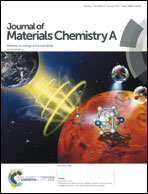All-polymer solar cells based on a novel narrow-bandgap polymer acceptor with power conversion efficiency over 10%†
Abstract
In this work, a novel narrow-bandgap conjugated polymer acceptor (PN1) based on electron-withdrawing 3,9-bis(2-methylene-(3-(1,1-dicyanomethylene)-indanone))-5,5,11,11-tetrakis[3-((2-hexyldecyl)oxy)benzene]-dithieno[2,3-d:2′,3′-d′]-s-indaceno[1,2-b:5,6-b′]dithiophene as the core building block and thiophene as the linking unit was developed and applied in all-polymer solar cells (all-PSCs). The PN1 exhibits a broad and strong absorption in the region of 550–800 nm with a high maximum extinction coefficient of 1.28 × 105 cm−1, a high electron mobility of 9.39 × 10−4 cm2 V−1 s−1 and more ordered molecular packing. In addition, it also possesses a relatively higher lowest unoccupied molecular orbital (LUMO) of −3.85 eV, which is beneficial to improve open circuit voltage (Voc) and reduce the energy loss of the device. By matching with the wide bandgap polymer donor PM6, the all-PSCs achieved a power conversion efficiency (PCE) of 10.5% with a large Voc of 1.0 V, a high short circuit current density (Jsc) of 15.2 mA cm−2 and a superior fill factor (FF) of 0.69. Our work demonstrated that PN1 is a promising polymer acceptor for application in all-PSCs.



 Please wait while we load your content...
Please wait while we load your content...